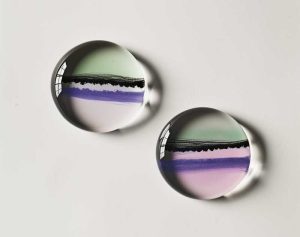Your UV Coating and EB Coating Questions are answered here…
-
-
How safe are UV/EB formulated, coatings, varnishes, adhesives and inks?
The raw materials available allow formulators to create products that are very low in skin irritability potential. However, these products, just like conventional products, are still chemicals that must be used with eye and skin protection. It is before cure, that precautions are advised when the wet product can be transferred to and from a person in handling and use. UV/EB formulations are 100% solids, and cure produces EPA recognized zero-low levels of emissions. The absence of solvents means there is no explosion/fire hazard.
- What concerns should I have about the safety of equipment? Both UV and EB equipment providers design safety into curing equipment. Interlocks prevent operators from being exposed to the curing zones. Shielding prevents operator exposure to UV light emissions in the form of bright white light, or UV wavelengths and any potentially dangerous EB processor emissions.
- How do I wash up when exposed to wet UV/EB curables? Wash-up can be as simple as using soap and water. Solvents should not be used for hand-body washing as they open the pores to exposure of UV/EB materials. Equipment wash-up is sometimes better done using low VOC recommended solutions. Please contact �鶹��ý���� Industries for recommended products.
- How should I clean up if a UV lamp breaks? When a UV lamp breaks a small amount of mercury is spilled. Have personnel leave the area. Do not track with shoes. Place contaminated clothes in disposable garbage bags. DO NOT use a vacuum cleaner or broom to collect. USE adhesive tape or an eyedropper to collect. USE a mercury spill kit to bind up the smallest mercury articles. Wash the area with a trisodium phosphate solution and rinse with water. Remove and discard any contaminated carpeting. Discard all collected materials within normal trash pickup.
- What kind of blankets should be used? Use rubber blankets, supplier recommended as the best for the type of work being done.
- What type of rubber rolls should be used? 100% UV/EB use requires EPDM, butyl nitrilic, vinyl nitrile, or buna-N rollers.
- What type of plates should be used? Positive and negative deep etch, bi-metallic, or photopolymer are recommended.
- Do I need to be concerned about light & lighting in the pressroom? There are sufficient UV emissions from sunlight and certain plant lighting to negatively affect UV inks. UV light filter sheets and tubes are recommended to cover exterior windows and florescent bulbs. No UV products should be left in the press.
- What is The simple difference between UV and EB formulated products? UV products contain a photo-initiator package which is used to trigger the cross linking polymerization of the systems 100% solid resins upon exposure to weak photons of UV light. EB curables, without photo initiators, are cured when exposed to the high-energy electrons generated by an EB processor.
- Do I need to be concerned about the temperature of the UV/EB curables that I bring to the press/coater to use? Very definitely yes! UV/EB formulated products are affected by temperature with viscosity or flow decreasing as temperatures drop and rising as temperatures rise. Formulators design products to run at ambient press room temperatures of 70-77° F., 21.1-25° C. UV curables should be acclimated to ambient press room temperatures before use.
- Can UV/EB curables be stored too long? Polymerization curing of energy curing products is a chemical reaction, so storage time is limited and affected by temperature. Expect a one year shelf life for unopened containers under the ideal storage temperature of 12-18° C., 53.6-64.4° F.
- What can cause UV curing to be inadequate? Lamp output that is below specifications due to age, or power supply issues and dirty lamps and reflectors will diminish cure energy. Coating/printing line speed can be too high exceeding curing equipment and ink/coating cure speed parameters. Wet coat weight could be too heavy for cure capacity. Check line cure capability using a UV radiometer.
- When should a UV dryer be cleaned? Follow the equipment supplier’s guidelines; curing is only as efficient as a dryer putting specified UV light output into the curing zone. Lamp output needs to meet spec with wattage output at par, focused and reflected properly. Clean reflectors weekly using a soft cloth and pure alcohol. DO NOT use UV cleaning solvent. Never touch UV lamps with bare fingers.
- When curing is inadequate what can a printer/coater do? Try to finish the job at a lower line speed. Check for proper ink density and wet coating weight. Check lamp output performance, clean reflectors, replace lamps. Contact �鶹��ý���� Experts for additional assistance.
- What tests are used to check cure? One can use a number of tests such as a felt tipped marker wipe, a solvent resistance test involving MEK rubs, an adhesion test involving tape adhesion and peel, a scratch resistance test involving scratching with a sharp hard fingernail or coin, a potassium permanganate test involving application and a check for staining, a pencil hardness scratch test and abrasion rub resistance testing. Contact �鶹��ý���� Industries for the latest methods and procedures.
- What is recommended when adhesion is poor? First check and be sure that the surface tension of the substrate is over 40 dyne. When over coating inks, be sure that waxes are not lowering surface tension. Films may be corona treated to raise surface tension to an adequate level. Primer coatings can also be applied to better accept over coatings. Be sure that dryer output is effective.
- Are some colors easier to cure? Opacity leads to an inability for UV light to penetrate the wet film and initiate and complete curing. Typically, metallic, opaque white, black, and dark colors are more difficult to cure.
- Should eyewear and gloves be used when handling UV curable materials? A variety of disposable chemically resistant gloves are recommended. Also UV barrier creams can be used. UV protective eyewear is always recommended.
- How should a spill be cleaned up? Remember that wet, uncured, UV materials could be transferred easily and sometimes almost invisibly (clears especially). Therefore, it is essential that a spill be dammed and absorbed with clean-up granules, scooped up and disposed of properly.
- Can UV/EB printed/coated paper, paperboard products be recycled? Yes, a lengthy study conducted by Beloit Corp. concluded that UV/EB cured products are just as recyclable as other conventional materials.
- Why use UV/EB curing? Both processes allow printing to be produced with higher quality. You can obtain improved color density with very little dot gain, printing, varnishing, and coating at higher speeds, gaining productivity. Both processes consume less electrical energy than do hot air thermal ovens or IR emitters. Coatings offer dramatically higher, deeper gloss!
- How do the costs of UV/EB curable products compare to conventional products? Although UV/EB curing products are higher in cost, as much as twice the cost, on a pound basis than conventional products, the cost on an applied coverage basis can be competitive. UV/EB curable products are 100% solids. This means that UV/EB curables go farther; less ink, coating, varnish or adhesive is required. There is no ink oil to be absorbed or solvent to be evaporated. UV/EB curables do not dry up during use; they do not require daily wash-ups wasting product. When all is considered, faster start-up times, faster printing, less waste, less labor, lower energy costs, the net is that UV/EB curing can actually be less costly.
- What amount of power is required to reach full cure? The curing of UV/EB curables depends on the thickness or amount of product there is to cure and press or process speed. Whenever the thickness of applied UV/EB curables is increased, more UV or EB energy may be required. Since the criteria are cure integrity, one needs to test to determine that cure is adequate and meets end product specifications.
- What humidity and temperature levels are recommended in the pressroom? Humidity and temperature can have a great effect on printing/coating affecting substrates mainly. It is highly recommended that humidity be maintained at 60% and temperature at 64-68° F, 18-20° C.
- What amount of UV energy does a UV lamp emit? UV energy impacting a UV curable is dependent on lamp housing, bulb dimension and optics. The operating power of a lamp is expressed in watts per inch of bulb length. Typically this could range from 200 to 600+ watts per inch. UV energy output is combined integrated energy or dose and peak irradiance. Output/dose is measured in milli-joules per centimeter squared (mJ/cm2) and watts, the focused power directly under the lamp. The longer the time of exposure, the greater the dose/energy impacting the UV curable. Irradiance is not time dependent and is the same at all curing line speeds.
- How long will a UV lamp last? Most UV lamps are warranted for a use of 1,000 hours, but many will last longer, even 2,000 useful hours. Lamp life depends on the curing power levels used. When low and medium power levels are only used, a lamps useful life is extended. Poor maintenance, dirty bulbs and reflectors that cause power levels to be raised will shorten lamp life. Improper air or cooling water flow to a lamp housing, raising lamp- housing heat, will shorten lamp life too.
- How is EB power described? Dose rate translates to the amount of energy delivered to the cure zone. Dose is expressed in megarads and it is a function of the electron beam current, the accelerating voltage applied and the speed of the product to be cured moving past or through the cure zone. EB penetrating curing power (accelerated electrons) in an EB curable material is directly related to the accelerating voltage applied.
- What is the function of photo-initiators? The fundamental role of photo-initiators in UV curables is to react to low energy photons of UV light so that the cross-linking UV cure is initiated.
- What do I have to do to safely dispose of cured or uncured UV/EB curables? Cured UV/EB curables are not hazardous waste so they can be disposed of in the normal waste. Uncured UV/EB curables are another matter and care must be taken to dispose of them properly per state, local and federal regulations.
- Is it possible to use UV/EB curables on heat sensitive thin film substrates? Heat management is the key to successfully using thin films in UV curing systems. The UV lamp quartz tube operates at about 900°C and it emits infrared radiation (IR). Customarily, UV systems are designed to control heat by using either air or water cooled lamp housings. Technology is also available in the form of dichroic shutters and dichroic quartz filters that control IR radiated heat, so that thin films can be printed/coated. Chill rolls or cold plates under the substrate are also sometimes used. The EB process does not generate excessive heat so the use of EB curables on thin films is not an issue.
- Is it advisable to turn off UV lamps during a rest, lunch or other breaks from production? The more UV lamps are switched on and off the more the life cycle of the lamp is affected. Switch them on and off too often and a drastic shortening of lamp life will occur. Follow UV equipment mfrs guidelines, which usually recommend: • Use the standby mode for short production disruptions of up to ½ hour. • Shut the lamps off when a shutdown of more than an hour is expected.
- What happens to UV equipment during an emergency stop? When an emergency stop is triggered, the modules cooling system continues to run and generally the UV lamps are turned off to protect UV equipment.
- What causes brittleness in UV coatings? Brittleness generally shows up as cracking during scoring of substrates or as poor scratch resistance. The cause is excessive cross-linking and/or a coating that is not well matched to the operations UV lamps energy output.
-
Your questions not answered here? Please do not hesitate to contact our UV/EB experts; click the “Expert Help” button on the right.







